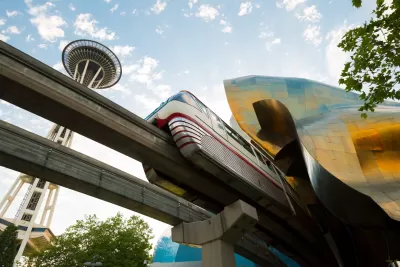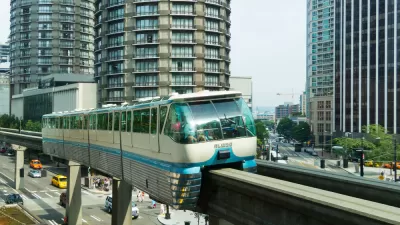Seattle’s new professional hockey team is drawing legions of enthusiastic fans. Around a quarter of them are taking public transit, such as the city’s often-maligned monorail, to games.

It’s not just Taylor Swift who can move people to take transit. Among all the doom and gloom public transit stories, there’s a ray of hope, according to an article by David Kroman in The Seattle Times: the Seattle Center Monorail (cue The Simpsons ‘Monorail’ song, for those of us of a certain age).
The elevated train — built for the 1962 World’s Fair and occasionally mocked in popular culture — saw better ridership in the first quarter of this year than it has in any similar period since at least 2009, easily outpacing its pre-pandemic ridership.
The Monorail’s high ridership can be traced to the success of Seattle’s brand new NHL hockey team, the Kraken, whose arena gave the Monorail a new ridership base. “ Through April, the monorail had 533,000 rides, about 150,000 more than the same period in 2022 and over 100,000 more than the same four months in 2019.”
Public transit was a key component of NHL Seattle’s strategy for limiting traffic congestion to the new stadium. “With each Kraken and Storm ticket, fans would receive a free pass on Sound Transit, Metro and/or the monorail, a benefit not available when the Sonics were still in town. This year, the arena added the perk to concerts and other events.”
Data from the team and transit agencies show that roughly 25 percent of fans are using transit to get to Kraken games, with a smaller percentage of people using transit for other events such as concerts.
FULL STORY: Seattle monorail rides the Kraken wave to higher ridership

Maui's Vacation Rental Debate Turns Ugly
Verbal attacks, misinformation campaigns and fistfights plague a high-stakes debate to convert thousands of vacation rentals into long-term housing.

Planetizen Federal Action Tracker
A weekly monitor of how Trump’s orders and actions are impacting planners and planning in America.

In Urban Planning, AI Prompting Could be the New Design Thinking
Creativity has long been key to great urban design. What if we see AI as our new creative partner?

King County Supportive Housing Program Offers Hope for Unhoused Residents
The county is taking a ‘Housing First’ approach that prioritizes getting people into housing, then offering wraparound supportive services.

Researchers Use AI to Get Clearer Picture of US Housing
Analysts are using artificial intelligence to supercharge their research by allowing them to comb through data faster. Though these AI tools can be error prone, they save time and housing researchers are optimistic about the future.

Making Shared Micromobility More Inclusive
Cities and shared mobility system operators can do more to include people with disabilities in planning and operations, per a new report.
Urban Design for Planners 1: Software Tools
This six-course series explores essential urban design concepts using open source software and equips planners with the tools they need to participate fully in the urban design process.
Planning for Universal Design
Learn the tools for implementing Universal Design in planning regulations.
planning NEXT
Appalachian Highlands Housing Partners
Mpact (founded as Rail~Volution)
City of Camden Redevelopment Agency
City of Astoria
City of Portland
City of Laramie




























